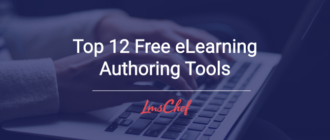As an independent LMS consultant, I understand the importance of harnessing the power of technology to enhance education and training. In today’s digital age, traditional methods of learning and development are being transformed by innovative solutions such as LMS platforms. These robust systems offer a wealth of features that can revolutionize the way organizations deliver and manage their learning programs.
In this article, I will provide you with a comprehensive overview of what a learning management system is, its core features, benefits, and how to utilize it effectively. Whether you are an educator or a corporate trainer, understanding the fundamentals of an LMS will empower you to make informed decisions and optimize your learning experiences.
So, let’s dive in and explore the world of learning management systems, unraveling the possibilities they hold for effective training.
What Is a Learning Management System (LMS)?
An LMS is a software application designed to facilitate the management, delivery, and tracking of online courses and complete training programs. It serves as a centralized platform where learners can access training materials, complete courses and assessments, and track their progress.
With the ability to deliver training remotely, an LMS transcends geographical barriers and enables organizations to reach a global audience. It promotes self-paced learning, allowing learners to progress at their own speed and revisit materials as needed. Furthermore, an LMS fosters interactive learning through multimedia elements, discussion forums, and gamification techniques, making the learning journey more engaging and impactful.
For L&D professionals, an LMS is also a great way to facilitate training. Most powerful platforms come with a wide set of automation features like automatic enrollment in courses, reminders, and invitations to upcoming events. All this helps automate tedious, yet extremely important, routines, thus freeing up trainers’ and administrators’ time for other meaningful tasks.
What Is a Learning Management System Used For?
I’m often asked about how an LMS can be used, and some people get very surprised when they find out that an LMS can benefit them in so many ways. Let’s explore what an LMS can be used for and how it can transform the training processes.

Centralized learning platform
One of the primary purposes of an LMS is to provide a centralized system for managing and delivering learning content. It serves as a repository where organizations can store and organize training materials, courses, videos, documents, and other resources. This centralized approach ensures that all relevant learning materials are easy for learners to access anytime, anywhere.
Course creation and delivery
All LMSs enable the delivery of online courses. But most advanced platforms also come with built-in tools for creating elearning courses. In fact, there is a growing trend that LMSs receive content building tools and turn them into complete online training solutions. This makes them a type of e-learning ecosystem that doesn’t require any third-party apps. An LMS also facilitates training schedules, allowing learners to take courses at their own pace while maintaining a structured learning experience.
Tracking and reporting
LMS platform offers robust tracking and reporting features that provide valuable insights into learners’ performance. Organizations can monitor learner progress, completion rates, assessment scores, and other relevant metrics. This data helps identify areas of improvement, measure the effectiveness of training programs, and make data-driven decisions to enhance learning outcomes.
Collaboration and communication
Modern training software foster collaboration and communication among learners and instructors. Discussion forums, chats, and other social online learning tools within the LMS facilitate knowledge sharing and peer interaction.
Assessment and feedback
An LMS simplifies the process of creating and administering assessments. All systems allow for the uploading and delivering of online quizzes to learners, and many of them also let you create assessments right on the platform. Once completing a quiz, learners receive instant feedback, so they can see the areas in which they need to improve.
Certification and compliance management
Many industries require employees to comply with specific regulations and obtain certifications. An LMS streamlines certification management by delivering certification courses, tracking employee progress, and issuing certificates upon successful completion. The most robust solutions even allow you to automate regulatory compliance training. You just need to set up automatic re-enrollment for your courses, and the LMS will enroll employees into training programs.
Performance management and skills development
The most advanced LMS platform also has integrated performance management tools, allowing companies to align online training initiatives with employee performance goals. By identifying skill gaps and offering targeted learning opportunities, organizations can enhance employee performance, support career development, and foster a culture of continuous learning.
Who Needs a Learning Management System?
In this article, I will mostly focus on corporate training that is typical for retail, healthcare, manufacturing, and many other businesses. But the truth is that many other organizations can also benefit from implementing an LMS. Let’s look at them in greater detail.

Corporations and businesses
For businesses, employee training and development are essential for maintaining a competitive edge. An LMS offers a comprehensive solution for onboarding new employees and continuous staff development. It allows organizations to create and distribute interactive training modules, track learner progress, and ensure compliance with industry regulations. An LMS can also facilitate skills development, performance management, and knowledge sharing across departments.
Educational institutions
Schools, colleges, universities, and other educational institutions can also benefit greatly from an LMS. It provides students with an opportunity to complete self-paced learning programs and collaborate with their classmates and a teacher in virtual classrooms. So, a platform enhances the learning experience by promoting collaboration, extending learning beyond the traditional classroom, and catering to diverse learning styles.
Nonprofit organizations
Nonprofit organizations often conduct programs for volunteers, staff members, and beneficiaries. An LMS helps streamline the process of creating and delivering training materials to learners, ensuring consistency and scalability. Just as importantly, it enables nonprofits to reach a wider audience – even in remote locations.
Governments and the public sector
Government agencies and public sector organizations can benefit from an LMS in a few ways. First, an LMS facilitates the delivery of compliance training, ensuring that employees stay up to date with regulations and policies. Second, it can support professional development initiatives for government personnel. And finally, it can help streamline development programs for citizens and enhance public education initiatives.
Professional associations and certification bodies
Professional associations and certification bodies often require that individuals complete specific online training and obtain certifications. An LMS provides a robust framework for managing certification programs, delivering training materials, and tracking candidate progress. In a nutshell, it helps to ensure the integrity and standardization of certification processes, simplifies administrative tasks, and offers a seamless experience for candidates seeking professional development and recognition.
Training and consulting providers
Organizations that specialize in training and consulting services can leverage an LMS to deliver their expertise to a broader audience. It allows them to create and monetize online courses and reach clients globally. In other words, an LMS is a great way to sell courses online.
Benefits of a Learning Management System

Implementation of a Learning Management System (LMS) can bring numerous benefits to all the organizations I’ve outlined above. They can be different, depending on their scope, but there are some benefits that are common to all of them.
Enhanced learning experience
LMS platforms offer interactive and engaging learning experiences. They support various content types, such as videos, interactive quizzes, and gamified training content, which serve to cover all training needs. Learners can progress at their own pace, access additional resources, and engage in collaborative activities, thus fostering a dynamic and personalized learning environment.
Scalability and cost savings
Traditional training methods often have limitations in terms of scalability. LMSs overcome this challenge by enabling organizations to deliver training to a large number of learners simultaneously. This eliminates the need for physical infrastructure, travel expenses, and printed course materials, resulting in significant cost savings as the reach of the training programs expands.
Automation and administrative efficiency
LMSs automate administrative tasks such as enrollment, registration, sending reminders and invitations, and generating certificates. This reduces manual effort and frees up time for instructors and administrators to focus on the more critical aspects of employee training.
Types of Learning Management Systems
Learning management systems come in different types, each catering to specific training needs. Let’s explore the existing types of LMSs so you can understand which one aligns best with your organization’s requirements.
Cloud-based LMS
A cloud-based learning management system, also known as a Software-as-a-Service (SaaS) LMS, is hosted on remote servers and is accessible through a web browser. Its main advantage is that there is no need for organizations to install LMS software on their own servers and maintain it. Cloud-based LMS providers handle infrastructure management, updates, and data security for the client. It is an ideal choice for organizations looking for hassle-free LMS implementation and scalability.
Open-source LMS
Open-source LMS solutions allow users to access and modify the source code according to their requirements. Organizations have the freedom to customize the LMS based on their specific training needs — to add new features or integrate with existing systems, for instance. These platforms offer flexibility and cost savings because there are no licensing fees. However, companies must have the technical expertise required to customize and maintain them.
Proprietary LMS
Proprietary LMSs (which are typically cloud based) refer to commercially available learning management systems developed and maintained by specific vendors. These solutions offer a wide range of functionalities designed to meet the training needs of organizations across various industries. While proprietary LMS vendors charge licensing fees, they usually provide robust features, seamless integration options, and high-quality customer training and support.
Mobile learning (mLearning) LMS
With the increasing use of mobile devices, mLearning LMSs have gained popularity. These platforms are optimized for mobile devices, allowing learners to access online training materials and complete training courses on smartphones and tablets. mLearning LMSs come with mobile-first interfaces and offline learning capabilities. They are especially beneficial for organizations that train sales representatives, cashiers, hospitality staff, and manufacturing workers because employees can look up necessary information and refresh their knowledge right at their workplace.
Integrated talent management LMS
This LMS goes beyond traditional learning management functionalities. It combines learning management with other talent management processes, such as performance management, succession planning, and career development. This integrated approach enables organizations to align online training initiatives with employee development and strategic business goals.
Social learning LMS
These platforms focus on social features, such as discussion forums, chat rooms, blogs, and social media integration. Learners can interact, share knowledge, and collaborate with peers and instructors online. A social learning LMS promotes community engagement, knowledge sharing, and informal learning and is particularly useful for organizations that prioritize collaborative learning and community building.
As you can see, there are many types of LMS. So, when selecting a solution, first assess the pros and cons of each type to make an informed decision.
Core Features of Any LMS
As a seasoned LMS consultant, I know how versatile the LMS market is and what a variety of features that LMS vendors provide. But here I’ll skip all the bells and whistles, staying focused on the key LMS features that each solid learning platform should have. Consider them when selecting a platform.
- Course management
An LMS should provide comprehensive content management capabilities, allowing you to create, organize, and administer courses effortlessly. This includes support of any possible content types, the structuring of course content, the ability to define access permissions, and efficient enrollment management.
- Learner management
Effective learner management is crucial for measuring training results and providing personalized learning experiences. You need an LMS that will allow you to manage learner courses and profiles, track enrollment records, monitor learner activity, and generate insightful reports on individual and group performance.
- Assessment
Assessments are at the heart of evaluating learners’ comprehension and progress. A good LMS enables you to conduct online evaluation, collect elearning assessment results with automated reports, and offer constructive feedback to learners.
- Progress tracking and reporting
Comprehensive user progress tracking and reporting features enable you to gain valuable insights into learners’ performance and overall engagement. Look for an LMS that offers detailed analytics, including course completion rates, assessment scores, and learner activity metrics.
- Mobile accessibility
In today’s mobile-driven world, it is imperative to choose an LMS that embraces mobile accessibility. Consider an LMS that is responsive and supports seamless access across multiple devices.
- Collaboration and communication
If you’d like to foster a collaborative learning environment, you’ll need an LMS that prioritizes communication and interaction among learners and instructors. Discussion forums, messaging capabilities, and videoconferencing can be very handy.
- Integration capabilities
To streamline your learning ecosystem, it is essential to consider the integration capabilities of the LMS. It’s better to opt for a platform that seamlessly integrates with your existing HR software, e-commerce platforms, or other learning tools, thus ensuring a cohesive and efficient learning experience.
- Security and data privacy
Protecting learner data and ensuring data privacy are paramount. When selecting an LMS, prioritize platforms that adhere to industry-standard security protocols and comply with relevant data protection regulations.
- Customization and branding
Your organization’s unique identity should be reflected in the learning experience. A solid LMS will provide you with customization features that will let you incorporate your branding elements into its user interface.
LMS Pricing Models
When it comes to choosing an LMS for your organization, understanding the pricing models is as essential as knowing its core capabilities. LMS providers offer different pricing options to accommodate various needs and budgets.

License fee/subscription
This is one of the most common models for LMSs. Organizations pay a fixed license fee or a recurring subscription fee to use the LMS. The cost typically depends on factors such as the number of users, features included, and support level.
Pay per Active user
In this model, organizations are charged based on the number of active users accessing the LMS within a specific period. Active users are typically defined as those who log in and engage with the system during that period. This model offers flexibility and cost control, as organizations only pay for the users who actively utilize the LMS.
Pay per learner
Similar to the pay per active user model, the pay per learner model charges organizations based on the number of learners using the LMS. This model is often used in educational institutions and training providers where learners may vary in terms of enrollment or course participation.
Pay as you go
This model allows companies to pay for an LMS based on usage or consumption. It typically involves paying for specific features or services used within the LMS, such as training content creation tools, assessments, or additional support.
Tiered pricing
Tiered pricing involves offering multiple plans with different features and user limits. Organizations can choose the tier that best suits their business needs, with higher tiers offering more advanced LMS features and accommodating larger user bases. This model provides flexibility and scalability options.
Free (open source)
Open-source LMSs are available at no cost and allow organizations to use, modify, and distribute LMS software freely. However, there may still be costs associated with hosting, customization, support, and maintenance.
How to Choose an LMS
I understand how important it is to select the best LMS that is right for you. With numerous options available in the market, it’s important to consider many factors to make an informed decision. Here are some steps to help you choose the best learning management system.

Step 1. Identify your organization’s needs
Begin by understanding your specific learning and training requirements. Determine the goals, learning objectives, and outcomes you want to achieve through the LMS.
Step 2. Define your budget
Establish a clear budget for your LMS investment. Consider factors such as upfront training costs, ongoing maintenance fees, and potential scalability expenses.
Step 3. Assess your technical requirements
Evaluate your organization’s technical infrastructure, including hardware, software, and network capabilities. Determine if you have everything you need to implement an LMS.
Step 4. Research LMS options
Conduct thorough research on different providers and platforms available in the market. Consider factors such as features, functionalities, user-friendliness, scalability, and customer training and support.
Step 5. Shortlist potential LMS providers
Based on your research, create a shortlist of providers that align with your organization’s training needs and budget. Narrow down the options to a manageable number.
Step 6. Request demos and trials
Contact the shortlisted LMS providers and request demos or trials of their platforms. This will allow you to explore the features and functionalities firsthand and assess if they meet your requirements.
Step 7. Make a final decision
Based on your evaluations and feedback, make an informed decision on the LMS that best aligns with your organization’s training needs, budget, and long-term goals.
This is just an outline of the steps you need to perform to select the best LMS. To stay organized with your LMS selection process, download this complete LMS buyer’s guide (it is the best one I’ve seen). It will walk you through how to evaluate an LMS and provide you with a bunch of templates and checklists that will help you in this important matter.
FAQ
Here are some frequently asked questions (FAQs) about learning management systems:
What are some popular examples of learning management systems?
As I’ve mentioned, there are hundreds of solutions on the market and I’ve reviewed a few that are always popular in my recent articles. Feel free to check them out here.
What is a SCORM-compatible LMS?
A SCORM-compatible LMS is a system that can handle and track SCORM e-learning content. SCORM is a set of standards for packaging and delivering online courses. With a SCORM-compatible LMS, organizations can easily import and track SCORM content, making it easier to use and monitor e-learning materials from different sources.
What technical expertise is required to use an LMS?
The level of technical expertise required can vary depending on the complexity of the LMS and your specific requirements. Many modern LMS platforms are designed with user-friendly interfaces and intuitive features, making them accessible to users with basic computer system skills. However, some customization or advanced configuration might require technical knowledge or assistance.
Conclusion
Throughout this guide, I’ve covered the basics of the LMS, its applications, key features, and different types of platforms. We’ve also discussed how an LMS can benefit organizations and factors to consider when choosing one. I hope you found this information helpful. Please tell me what you’d like me to add to this article or what other LMS-related topics to cover in the comment section below.






